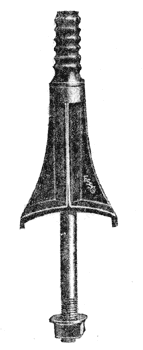[Trade Journal]
Publication: Electrical World
New York, NY, United States
p. 377, col. 1-2
TRUSS INSULATOR PIN.
The Electric Service Supplies Company, Philadelphia, has brought out a new insulator pin, known as the Keystone truss pin, which, it is claimed, overcomes every disadvantage of former types of truss pins and in addition has many other important advantages.
Heretofore it has been necessary to cement the complete pin in the insulator before erecting it. With the Keystone truss pin the thimble only is cemented in the insulator, which assembly is afterward mounted on the truss pin. The illustrations herewith show clearly the curved base of the pin with the lips that project over the sides of the cross-arm. This provides a bearing at the edge of the cross-arm. Therefore any pull at the top of the pin tends to lift the pin at its center, throwing a tensile strain on the bolt. It is claimed that with types of separate top pin which do not have the curved base the strain that comes on the stud bolt is a bending strain, resulting in a deflection back and forth each time that the strain comes on the wire in a different direction. As this bending back and forth continues, it weakens the bolt and digs a hole in the cross-arm, which permits water to enter and results in rotting and the final loosening of the bolt in the arm. The curved base, moreover, prevents water from settling in or around the bolt hole and prevents the rotting of the cross-arm at this point. The depending lips of the base find a bearing on each side of the arm; prevent the pin from turning and offer a most substantial side-strain construction.
 |
| Fig. 1 — Details of Truss Insulator Pin. |
Referring to the accompanying illustrations, the separate top or thimble A is designed for cementing into the insulator. This cementing may be done either by the customer or at the insulator factory, the latter being recommended because of the low cost and because insulators when received by the customer are at once ready for installation. This thimble is of malleable iron, cored and tapped to screw on to the upper end of bolt B as seen.
Bolt B, which is of solid drop-forged steel, of either 5/8-in. or 3/4-in. diameter and of the proper length to suit the cross-arm in use, is provided with a collar; which serves to hold it on a flange in base casting D, thus keeping it from dropping out when it is installed on the cross-arm. Washer B and nut F, of course, go on the under side of the cross-arm, thus allowing the bolt to be turned around as. desired. In using this pin a hole is bored through the arm, the base D is placed thereon and is held rigidly in place by the bolt B and nut F. The upper threaded end of the bolt B now projects above the top of casting D. and to this projection the insulator is screwed. If it does not align properly with the wire it is only necessary for a man to loosen the nut F, turn the insulator, bolt and all, until the groove is in the proper direction, then tighten the nut again. This allows the insulator to be adjusted exactly in alignment with the wire and at the same time remain absolutely tight on the pin.
 |
| Fig. 2 — Truss Insulator Pin. |
The Keystone truss pin features are also provided in a ridge iron and in a pole-top pin. By using this assembly the same insulators with separable thimbles cemented therein will fit either cross-arm, ridge iron or pole-top pins. Theo great advantage of this fact will be readily appreciated. It is claimed that the following important advantages may be obtained from the Keystone truss pin.
1. It can be used wherever any insulator with thimbles cemented in is used. 2. The groove of the insulator can be aligned perfectly with the wire and at the same time the insulator and pin be kept perfectly tight. 3. Lead does not reed to be used at all to obtain flexibility in aligning the insulator with the wire. 4. All cementing is done under ideal conditions rather than in the field; consequently perfect results are always obtained. 5. The pin behaves perfectly under heavy lateral strains. 6. The insulator can never come loose under service conditions. 7. It is very easy to install in the first place, and damaged insulators can easily be replaced with new ones. 8. The pin cannot turn on the cross-arm. 9. Wood under the pin and around the bolt hole cannot rot, thus adding life to the cross-arm, 10. Used in connection with ridge iron or pole-top pin construction, all of the advantages of use as a cross-arm pin apply and but one standard insulator is needed.
